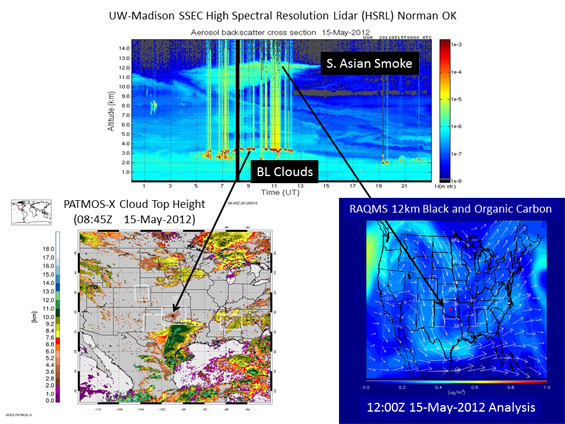SSEC/CIMSS Supports Deep Convective Clouds and Chemistry (DC3) Field Campaign
Science flights for the National Science Foundation (NSF) Deep Convective Clouds and Chemistry (DC3) field campaign investigating the impact of deep, midlatitude continental convective clouds are now underway.
SSEC/CIMSS researchers Ed Eloranta and Dave Turner, in conjunction with the Advanced Satellite Products Branch (ASPB), are providing real-time High Spectral Resolution Lidar (HSRL) measurements to the DC3 mission scientists to assist in flight planning.
May 15, 2012 HSRL backscatter cross section measurements in Norman, OK, show Planetary Boundary Layer (PBL) aerosols, cloud formation at the top of the PBL (3km), and upper tropospheric (10-12km) aerosol enhancements on 15 May 2012. The 08:45Z PATMOS-X GOES Cloud Top Height retrievals over Norman, OK show very good agreement with the HSRL PBL cloud top heights. RAQMS 12Z black and organic carbon aerosol analyses show that the upper tropospheric aerosol enhancements are associated with Trans-Pacific transport of pollution from South Asian biomass burning.
Developed by Ed Eloranta, the SSEC HSRL instrument has been deployed to the National Severe Storms Laboratory (NSSL) in Norman, OK, and is being hosted by Dave Turner at NSSL. The DC3 campaign conducts research flights in Oklahoma, Texas, Colorado, and Alabama.
Data collected during DC3 will be used to validate GOES-R Advanced Baseline Imager (ABI) cloud and aerosol retrievals with support from the GOES-R Cal/Val program.

